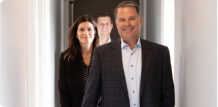About ten months ago, I wrote about my new bulldozer-yellow Jeep Wrangler, comparing the sensation of Driving with the Doors Off to investing in the New Normal, or as I like to call it, a “slow growth for as far as the eyes can see” environment. While the pavement had always been a mere twelve inches beneath my feet, Driving with The Doors Off made the experience far more real, far more alive, and far more aware of the risks that had always been there. In the New Normal it feels like we are always and everywhere just one small pothole away from the next economic disaster. (View a printable version of this Economic Update: Driving with the Doors Off, Part II)
After three successive growth scare years and summer stock market swoons, I had hoped 2013 would finally be different. At the beginning of the year, we predicted that the economy would finally move beyond the recovery phase and into an expansion, with the S&P 500 likely reaching new all-time highs. The budding and now blossoming improvements in the homebuilding and automobile sectors gave us confidence that after five long years of waiting, it would finally feel like we were making some real economic progress.
While the stock market did indeed reach new highs in relatively short order, the magnitude and nature of the gains surprised us. January got off to a strong, traditional start, but by the end of the month, the makeup of the market’s gains shifted gears dramatically, with defensive areas like consumer staples, utilities, and health care driving the bulk of the gains. As we discussed in our last update Like Baseball in the Snow, the market’s strong gains were fun to watch, but we found ourselves down in the count, unable to keep up with the stock market’s swift, defensive-led pace. Great pitching, we know, is necessary to keep the other team from scoring, but to win a game; some level of offense is required.
While the search for yield certainly contributed to the move, we found it difficult to believe that every senior citizen awoke on the morning of January 25th when defensive areas of the market started to gain momentum, and suddenly realized they held maturing bonds in their portfolio whose proceeds would need to find a home in a sensible income producing security with a yield greater than zero. Our view was that for the market’s gains to sustain themselves, the participation of cyclicals would need to kick into gear.
The stock market’s strength continued in May and fortunately for us, the new pattern of gains started to play out as expected. In an almost surreal fashion, nearly every investment strategist on the street appeared to adopt our line of thinking, claiming that given the big run in defensives, cyclicals were now the place to be.
In spite of strong second quarter earnings results and accommodative Federal Reserve policy, skepticism continues to pervade a market that is up nearly sixteen percent, year to date. Having ridden through the tech stock bubble in a front row seat, I can definitely say that this latest run has been a ho-hum experience, completely devoid of any form of exuberance that typically accompanies an asset bubble. I was shocked to hear that the last time the market had enjoyed such a strong start to the year was just last year, testament to short memories and the absence of any sustained giddiness.
About two weeks ago, earnings season started to draw to a close. While we made the decision to invest in a small basket of high revenue growth biotech stocks, we remained unconvinced that the bulk of the market’s year to date gainers were worthy of our growth oriented mandate.
Would we rather invest in pharmaceutical giants with big fat yields that were shrinking to greatness on the back of endless corporate spinouts or biotech companies that were getting approval for new drugs for MS and cancer? To borrow a phrase from Wayne Gretzky, did we want to invest in areas where the technology puck was today, like Oracle and IBM, or skate to areas where the puck would be in the future, like Google, Salesforce, Facebook and other cloud computing plays?
We just finished an analysis of both the companies we own and those we follow and in spite of concerns by some that the quarter’s earnings were decent but generally revenue-uninspiring, ours were not. In a slow growth environment, we want to own the innovators who sell compelling enough products that they find it easy to win your hard earned revenue dollar or the cyclical with an unusual theme for demand behind it, like the homebuilding recovery or the domestic manufacturing and energy renaissance. Dividend paying stocks certainly serve a purpose, but among the risk spectrum of investments, they really aren’t that growthy.
Historically, innovator or cycle independent growth stocks do well throughout all stages of the economic cycle, with the exception of recessions. For the very best, company fundamentals remain strong even in down economic times, but the stocks of all companies suffer.
Two weeks ago, Ben Bernanke uttered the five letter word “taper” and ever since, the investing world hasn’t been quite the same. After enjoying a strong run, dividend and defensive stocks pulled back first, and in a never ending search for reason, suggestions have been made that the back-up in treasury yields has made such stocks less attractive.
The ISM Manufacturing PMI survey results were also released recently, coming in at just under 50, a level which has been consistent with a contraction in manufacturing activity, but a far cry from recessionary readings often in the lower 40’s. A reading of just under 50 in the ISM, I guess, is a lot like Driving with The Doors Off, especially when you can still see three summer growth scares and a Great Recession vividly in your rearview mirror. While a broader, competing PMI survey by Markit mirrored the very bullish reading of new orders from the auto industry heavy, Chicago regional PMI, the markets didn’t appear to notice.
The S&P 500 is only 3.5% off its all-time highs but under the surface is acting as though the economy is getting ready to drive right off the cliff. During earnings season, pessimists bemoaned the fact that while profit growth was generally strong, year over year revenue growth appeared anemic. Now, the crazy reality is that the very companies which did manage to post outstanding revenue growth (fifteen percent or more) are also those that are getting hit the hardest and certainly more than the market’s most recent pullback. It’s damned if you do, damned if you don’t!
Personally, I believe that the change in the tone of the markets is almost entirely due to our new reality. We are Driving with The Doors Off. In spite of three years of experience which has shown that negative economic data points and concerns about shifting Fed policy don’t derail LONG TERM stock market gains, we’re still in an environment that gives investors enormous short term, stock market jitters.
Today, I read an article by famed bond fund manager Bill Gross, entitled a “Wounded Heart.” In the update, Bill mentions that the Federal Reserve has kept rates too low for too long and that as a result, the investing public and corporate America aren’t willing to engage in normal risk taking endeavors given the lack of carry and adequate incentives. While I agree with part of his arguments and can see it in the preference of corporate boards to focus on dividends and stock buybacks rather than new growth initiatives, I also get the notion that we as a society have somehow forgotten what risk taking is all about in the first place.
In real terms, if you invest in a security like a United States Treasury bond that is thought to be risk-free, wouldn’t good old mom suggest you should earn no real return? Why do we ask those who issue municipal bonds to get those bonds insured against principal risk? Isn’t that what the coupon is for? If not, why should there be any real return? If your bank gives you a mortgage with less than 20% down and requires you to buy private mortgage insurance, why should the bank get a full, risk based return? If you buy a variable annuity that promises equity like upside but protection on the downside, who is fooling whom?
I think we are over-insured, under-risked wimps when it comes to investing. We fool ourselves into thinking that we really can have a free lunch, that we can receive long term pension benefits without providing long term labor or a return on an investment without providing long term capital. In my eyes, it’s not that the incentives aren’t in place or that the carry isn’t enough, it’s that we’ve been sold a false bag of goods and bought into the idea hook, line and sinker.
Our thesis remains the same. We are in a New Normal and growth will remain slow for as far as the eyes can see. While the economy is expanding to new, record levels of activity, short term anxiety levels are subject to flare ups. Only with the passage of time will we start to forget the anxieties of the immediate past and relearn the lesson that over time, things tend to improve, but that we must first be willing to give up something of value to receive something in return.
We do not see an imminent recession nor have we seen one in each of the last three years in spite of signals by the stock market that have made it feel otherwise. Sometimes, often in fact, you have to ride through the ups and downs to be entitled to the gains on the other side. Entitlements may need reforming on both sides of the aisle!
The belief that you can find a 2/20 hedge fund manager who earns high returns with little relative risk isn’t progressive investment thinking; it’s a notion which history has shown time and time again exists only in the Realm of Puppy Dogs and Rainbows.
Kindest Regards,
Doug MacKay, CEO & CIO
Bill Hoover, President
Mike Czekaj, Research Analyst



